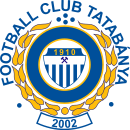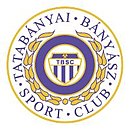FC Tatabánya
| FC Tatabánya | |||

|
|||
| Basic data | |||
|---|---|---|---|
| Surname | Football Club Tatabánya | ||
| Seat | Tatabánya | ||
| founding | 2002 | ||
| Colours | blue White | ||
| president | Bolla Krisztián | ||
| Website | tatabanyafc.hu | ||
| First soccer team | |||
| Head coach | Gyula Plotár | ||
| Venue | Tatabánya Stadium | ||
| Places | 16,000 | ||
| league | Nemzeti Bajnokság III , west | ||
| 2014/15 | 6th place | ||
|
|
|||
The Football Club Tatabánya is a football club from the city of Tatabanya in the northwest of Hungary . The association was founded in 2002 as the successor to Tatabányai Bányász SC, which was founded in 1910 . In continuation of its tradition, he uses blue and white as the club colors. The club rose in 1948 for the first time in the Nemzeti Bajnokság I. , the highest Hungarian league.
history
On February 6, 1910, the mining engineer Ferenc Frei and Lajos Szmuk founded the Tatabányai Sport Club for short, TSC, with local football friends . On the founding day, Frei assumed the office of President, Szmuk that of Secretary.
Right from the start, blue and white were set as the club colors, and the first club motto was also written: courage, strength, masculinity . The records from this period tell of a flourishing football life in the Tatabanya area, but the first "official" game was played on August 21, 1910. The TSC developed into a local player in the next few years, and in 1913 a Hungarian sports journal even dubbed the Tatabányai Sport Club the strongest club in the whole country.
Club life was brought to a standstill by the First World War , but just a few years later football developed into the most popular sport in the region. The Tatabányai SC played in the Regionalliga West and was mostly in the top group. When a professional league was first introduced in Hungary in the 1925/26 season, the TSC could not guarantee the necessary finances and was forced to compete in the amateur league. The club's performances were extremely unstable in the following years, but after the Second World War the TSC slowly approached the level of the upper house teams in Hungary.
After the Second World War
In the game year 1947/48 he was promoted to the upper house of Hungarian football for the first time, which was all the more important since Hungarian football belonged to the world's elite at that time. The political support of heavy industry was helpful . In the first season, the team finished only 13th and thus had to go to the second division, in which they remained for three years.
After the recovery, the TSC was only able to place itself in 16th place in the 1st Hungarian league and again rose to the second league. Until 1955, the club played second class, but in 1956 it was promoted again. The following year they managed to stay in the first division for the first time.
In the 1957/58 season, the Tatabányai SC finished seventh, before the club celebrated its greatest success to date with fourth place in the table in the following season and was awarded the title "Best Provincial Team".
The goalkeeper at this time was Gyula Grosics, known from the " Golden Team " (Aranycsapat), who was finally banned from Honvéd Budapest after the World Cup defeat in 1954 and stood between the posts at the club from 1956 to 1962. In 1960 Tatabánya was one of the six clubs that represented Hungary in the Mitropa Cup. The club remained superior in the games against Rudá Hvězda Bratislava and helped Hungary to victory in this year's competition with a nation ranking.
At the 1964 Olympic Games in Tokyo , two football players from Tatabánya, Tibor Csernai and József Gelei , won the gold medal with the Hungarian national team in the final against Czechoslovakia.
In 1966 Nándor Hidegkuti , a famous member of the former Golden Team , coached the club. Two players represented the club this year at the World Cup in England, which defeated Brazil and finished the tournament in 6th place.
At the 1968 Olympic Games in Mexico , two TBSC players were again among the winners. At the 1972 Olympics in Munich , two players from Tatabánya belonged to the Hungarian team that won the silver medal there.
This year Tatabánya also advanced to the final of the Hungarian Cup for the first time , but lost 2-1 to the FTC Budapest . During these years Tatabánya was one of the leading clubs in Hungarian football.
Participation in the Mitropapokal 1973 was a bigger success, because the club, which at the time was called Tatabányai Bányász SC , defeated the Yugoslav club Celik Zenica in the two finals . The following year he was able to defend the title against ZVL Žilina from Czechoslovakia .
In the 80s Tatabánya was again one of the leading teams in Hungary and moved back to the Hungarian Cup final in 1985, but lost there with a 5-0 defeat by Honvéd Budapest . In 1981 Tatabánya was runner-up and achieved his best league placement to date. In 1988 the club was able to repeat this success.
After the reunification in Hungary, the club began to decline. In 1993 the team started only in the 3rd division and was close to bankruptcy.
After the 1997/98 season, the club returned to the 2nd division. Under the leadership of József Kiprich , who had returned from abroad , Tatabánya was promoted to the House of Lords again in 1999 and also made it into the Hungarian Cup final, but lost 2-0 to the Debreceni VSC there .
In the new millennium
The next few years were turbulent and led to relegation and finally the re-establishment of the club in 2002 as Auto Trader Tatabánya . 2005 succeeded in being promoted to the first division, in which the club was able to introduce itself with a fifth place. In the 2006/07 season it was only enough for twelfth place.
The 2007/08 season was more than disastrous. Of the first twelve games, a draw was only achieved once. After 30 games, the team had two wins and a total of ten points, which meant the clear relegation. The distance to a non-relegation place was 17 points. In the second division Tatabánya established in the following years in the upper third of the western group.
European Cup balance sheet
| season | competition | round | opponent | total | To | Back |
|---|---|---|---|---|---|---|
| 1981/82 | Uefa cup | 1 round |
|
2: 2 ( a ) | 2: 1 (H) | 0: 1 (A) |
| 1982/83 | Uefa cup | 1 round |
|
1: 4 | 1: 4 (A) | 0: 0 (H) |
| 1985/86 | UEFA Cup Winners' Cup | 1 round |
|
1: 6 | 0: 5 (A) | 1: 1 (H) |
| 1987/88 | Uefa cup | 1 round |
|
1: 2 | 1: 1 (H) | 0: 1 (A) |
| 1988/89 | Uefa cup | 1 round |
|
2: 3 | 0: 2 (A) | 2: 1 (H) |
| 2000 | UEFA Intertoto Cup | 1 round |
|
7-0 | 4: 0 (A) | 3: 0 (H) |
| 2nd round |
|
3: 2 | 3: 2 (H) | 0: 0 (A) | ||
| 3rd round |
|
2: 4 | 1: 2 (A) | 1: 2 (H) | ||
| 2001 | UEFA Intertoto Cup | 1 round |
|
5: 4 | 2: 3 (H) | 3: 1 (A) |
| 2nd round |
|
5: 1 | 1: 1 (A) | 4: 0 (H) | ||
| 3rd round |
|
2: 3 | 1: 2 (A) | 1: 1 (H) |
Overall record: 22 games, 7 wins, 6 draws, 9 defeats, 31:31 goals (goal difference ± 0)
Name changes
- 1910 Tatabánya (Tatabányai Sport Club)
- 1949 Tatabánya (Tatabányai Tárna)
- 1950 Tatabánya (Tatabányai Bányász Sport Club)
- 1992 Tatabánya (Tatabányai Sport Club)
- 1998 Tatabánya (Lombard Futball Club Tatabánya)
- 1999 Tatabánya (Football Club Tatabánya)
- 2000 Tatabánya (Lombard Futball Club Tatabánya)
- 2004 Tatabánya (Auto Trader Tatabánya Football Club)
- 2005 Tatabánya (Football Club Tatabánya)
successes
- Mitropapokal: 1973, 1974 (as Tatabányai Bányász SC )
- Runner-up : 1981, 1988
- Cup finalist : 1972, 1985, 1999
player
-
 Gyula Grosics (1956–1962)
Gyula Grosics (1956–1962) -
 József Kiprich (1980–1989, 1998–1999) player, (1999–2001) player-coach,
József Kiprich (1980–1989, 1998–1999) player, (1999–2001) player-coach, -
 Vukašin Poleksić (2006-2008)
Vukašin Poleksić (2006-2008)
Trainer
-
 Nándor Hidegkuti (1960)
Nándor Hidegkuti (1960) -
 József Kiprich (1999–2001, 2011–2012)
József Kiprich (1999–2001, 2011–2012)
Web links
- Association website
- Further website about the association
- FC Tatabánya on weltfussball.de (team, line-ups, results, etc.)
